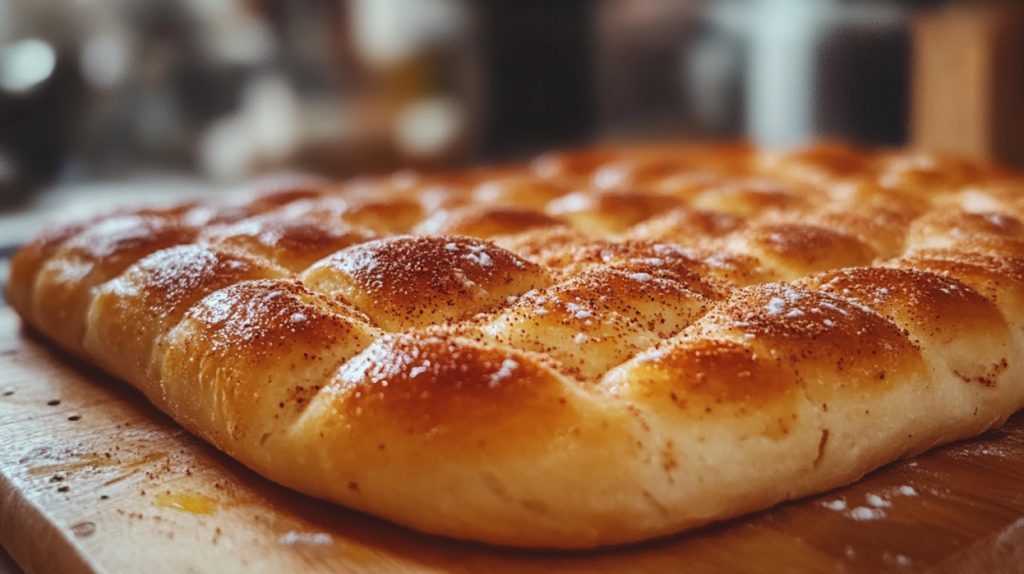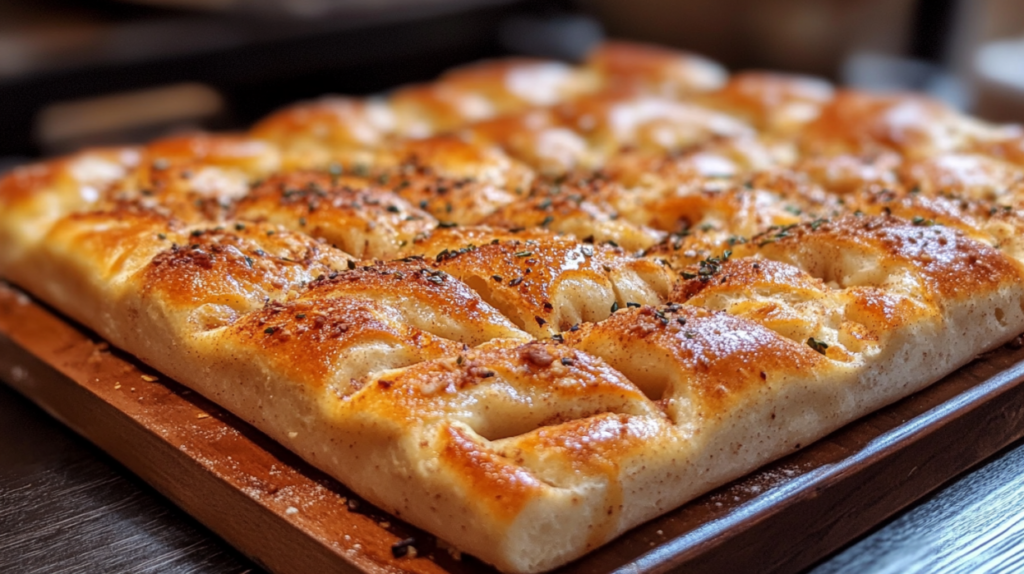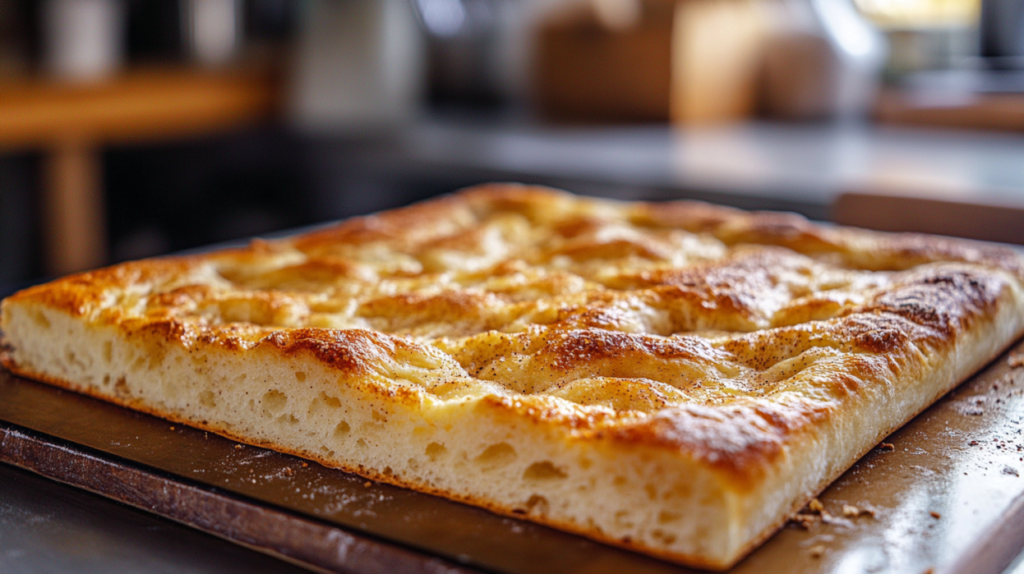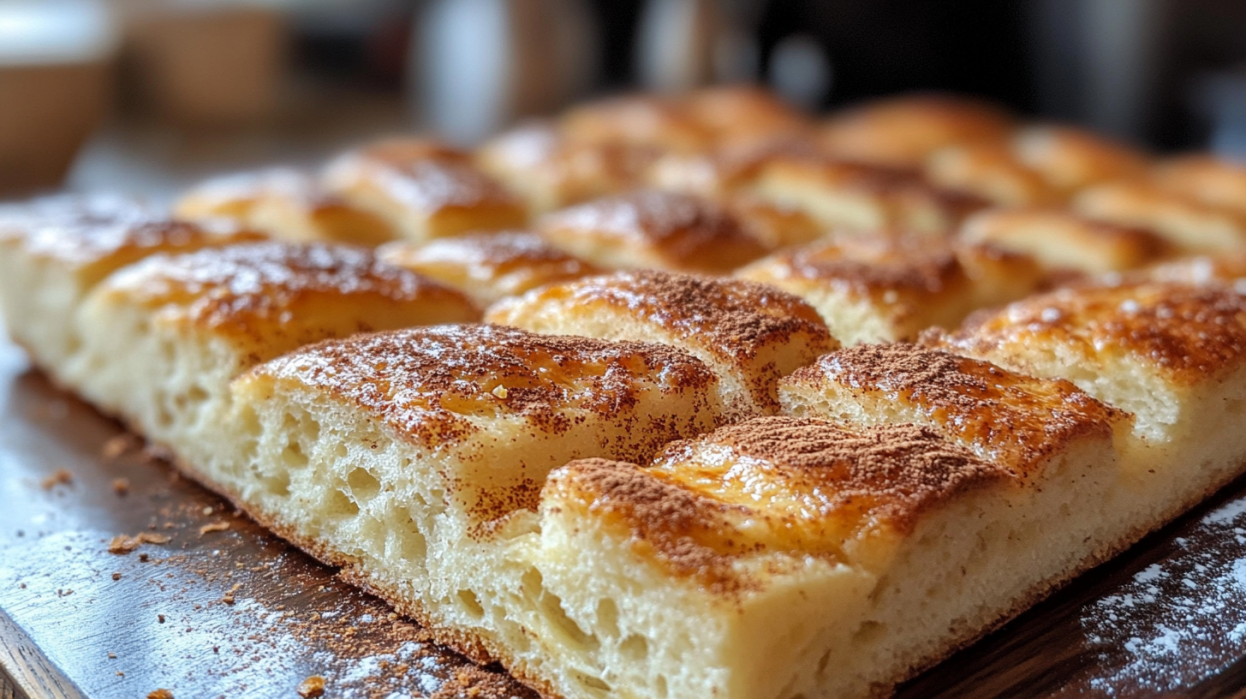Cinnamon Focaccia is a recipe that blends the familiar with the unexpected, much like my own journey. Growing up above my grandmother’s trattoria in Bologna, Italy, the kitchen was always where life happened. Every meal was a story, and every dish had a piece of her love. Now, as a chef in Brooklyn, I bring a little piece of that Italian tradition to the bustling New York kitchen, but with a modern twist.
This Cinnamon Focaccia is my way of taking the soft, pillowy Italian bread I grew up with and adding the sweet warmth of cinnamon. It’s a reflection of who I am—deeply Italian, with a touch of New York spice. Simple ingredients, a little bit of love, and a dash of creativity, just like the recipes I learned from my grandmother. Let’s dive in and make something magical together!
Table of Contents
What is Cinnamon Focaccia?
Understanding the Basics of Focaccia
Focaccia is one of Italy’s most beloved breads, known for its soft, fluffy texture and the comforting richness that comes from the generous use of olive oil. Traditionally, focaccia is savory—seasoned with herbs like rosemary, sea salt, and sometimes olives. But Cinnamon Focaccia takes this classic Italian bread in a sweet direction, combining the familiar texture of focaccia with the warm, aromatic sweetness of cinnamon.
While it may sound like an unexpected combination, cinnamon and bread have always had a close relationship in the world of baking. The result is a bread that’s tender, slightly sweet, and packed with flavor—a perfect balance between savory and sweet. Cinnamon Focaccia is a versatile treat that can be enjoyed as a breakfast, a snack, or even a dessert, all while maintaining the comforting essence of Italian bread.
Why Cinnamon Works in Focaccia

So, why does cinnamon pair so perfectly with focaccia? The answer lies in the bread’s texture. Focaccia’s dough is soft and airy, which creates a perfect canvas for cinnamon’s sweet and spicy notes. The cinnamon sugar melts into the bread as it bakes, giving every bite a warm, comforting flavor without overwhelming the lightness of the bread.
Plus, just like how an Italian grandmother might sneak a pinch of extra love into every dish, the cinnamon adds an element of surprise, turning an already beloved bread into something new and exciting. The best part? The aroma that fills your kitchen while baking—it’s as if you’ve brought a little bit of Italy and the cozy warmth of home right into your own space.
The Secret to Perfect Cinnamon Focaccia
The Role of the Dough
The key to making the perfect Cinnamon Focaccia lies in its dough. Focaccia is known for its soft, slightly chewy texture, which comes from the right balance of flour, water, yeast, and olive oil. When making cinnamon focaccia, it’s important to start with a dough that is slightly sticky but still workable. The olive oil adds richness and helps to create that signature, light crumb texture.
The dough should be kneaded just enough to develop the gluten and create elasticity, but not too much that it becomes tough. The goal is to have a dough that’s soft, slightly tacky to the touch, and able to stretch and puff up beautifully when baked. This texture is the perfect foundation for the cinnamon sugar that will infuse every bite.
The Importance of Proofing
Proofing is the magic ingredient that helps focaccia rise to its pillowy perfection. This step allows the yeast to work its magic, fermenting the dough and producing air pockets that make the bread light and airy. For the best results, let the dough rise twice: once in the bowl, and then again after shaping it on the baking sheet. This ensures the focaccia is fully aerated and will bake up soft, fluffy, and golden.
If you rush through the proofing stage, your cinnamon focaccia will lack that cloud-like texture we all crave in fresh bread. The longer, slower rise allows the yeast to develop deeper flavors, making the final product taste more complex and satisfying. Whether you’re baking a savory or sweet version, giving the dough time to rise is one of the most important steps in achieving the perfect focaccia.
The Secret to Perfect Cinnamon Focaccia
The Role of the Dough
The secret to a perfect Cinnamon Focaccia starts with the dough. Focaccia is known for its soft, tender crumb and slightly chewy texture, and achieving this balance is key. To create a delicious cinnamon version, it’s essential to start with a dough that is just the right consistency: slightly sticky, but still manageable. The olive oil in the dough not only adds flavor but also contributes to its light, airy texture—helping it rise beautifully in the oven.
The dough should be mixed until just combined, then kneaded enough to develop elasticity without overworking it. If you over-knead, you risk making the dough too tough, which can result in a denser bread. Aim for a dough that’s soft, pliable, and just a little tacky to the touch. This lightness and stretchiness will allow the cinnamon sugar to melt into the bread as it bakes, creating a perfectly sweet and flavorful loaf.
The Importance of Proofing
Proofing is one of the most important steps when making focaccia. This is where the yeast gets a chance to ferment, allowing the dough to rise and develop that airy, fluffy texture that focaccia is famous for. By allowing the dough to proof twice—once in the bowl and once after shaping it on the baking sheet—you give it the time it needs to reach its full potential.
If you rush through this process, you may end up with a denser Cinnamon Focaccia, which won’t have the same melt-in-your-mouth texture. A longer, slower rise gives the yeast plenty of time to develop complex flavors, making the final product more satisfying. This process is where the bread really comes to life, and the cinnamon and sugar will be absorbed into every soft layer, giving you a beautifully sweet, yet light, focaccia.
Is Focaccia Healthier Than Regular Bread?
Comparing Cinnamon Focaccia with Traditional Bread
When comparing Cinnamon Focaccia to traditional bread, there are a few notable differences. Focaccia is often made with a generous amount of olive oil, which sets it apart from most traditional breads. Olive oil is rich in monounsaturated fats, which promote heart health and offer various other health benefits, making it a better fat choice compared to butter or lard found in other types of bread. However, this additional oil gives focaccia a rich, indulgent texture that you won’t find in lighter, traditional loaves made simply from flour, water, and yeast.
Traditional bread tends to be leaner and less rich, which makes it a lighter choice for those watching their calorie intake. While focaccia’s texture is denser and more luxurious, the oil gives it a unique flavor and richness that many find irresistible. So, while focaccia may feel more indulgent, you can easily make adjustments to the recipe to make it a healthier choice by choosing whole wheat flour or reducing the oil.
The Caloric Difference
In general, focaccia is higher in calories than regular bread due to the extra olive oil and, in the case of Cinnamon Focaccia, the sugar added to the dough. The olive oil, while beneficial for heart health, still adds calories to the bread, which can make it a more calorie-dense option compared to simpler bread varieties. Additionally, adding sugar or sweeteners to create a cinnamon version only increases the overall calorie count.
If you want to enjoy a healthier version of Cinnamon Focaccia without losing its delightful texture, try making some swaps. You can reduce the sugar or experiment with natural sweeteners like honey or maple syrup. Another option is to use whole wheat flour instead of white flour, or even add seeds like flax or chia for an extra dose of fiber and nutrients. While focaccia is inherently more calorie-dense than other breads, these adjustments can make it a more nutritious choice without sacrificing flavor.
How to Make Cinnamon Focaccia: A Step-by-Step Guide

Ingredients You’ll Need
To make the perfect Cinnamon Focaccia, you’ll need the following ingredients:
- 500g all-purpose flour
- 1 packet of active dry yeast
- 300ml warm water
- 1 tablespoon of sugar (to activate the yeast)
- 1 teaspoon of salt
- 4 tablespoons of olive oil
- 2 teaspoons of ground cinnamon
- 100g brown sugar
- Extra olive oil for drizzling
- Optional: A small sprinkle of flaky sea salt for the finishing touch
Step-by-Step Instructions
Step 1: Activate the Yeast
In a small bowl, dissolve the sugar in warm water, then sprinkle the yeast on top. Let it sit for 5-10 minutes, and you’ll notice the mixture will become frothy and bubbly. This means the yeast is fully activated and ready to work.
Step 2: Mix the Dough
In a large bowl, combine the flour and salt. Make a well in the center and pour in the activated yeast mixture along with the olive oil. Stir the ingredients together until the dough begins to form a soft, slightly sticky texture. If the dough is too sticky, you can add a bit more flour, but be careful not to make it too dry. You want the dough to remain soft and slightly tacky.
Step 3: Knead the Dough
Turn the dough onto a lightly floured surface and knead it for 8-10 minutes, or until it becomes smooth, elastic, and easy to handle. The dough should be soft and pliable, with just a touch of stickiness remaining.
Step 4: First Proofing
Place the dough into a bowl that has been lightly greased with olive oil. Cover it with a clean towel or plastic wrap, and allow it to rise in a warm spot for about 1-2 hours, or until it has doubled in size.
Step 5: Shape the Focaccia
Once the dough has risen, gently punch it down to release any air. Transfer it to a greased baking sheet or pan, and stretch it out into your desired shape. Be sure to dimple the surface with your fingers, which creates the characteristic focaccia texture.
Step 6: Add the Cinnamon Sugar
In a small bowl, mix together the ground cinnamon and brown sugar. Sprinkle this cinnamon-sugar mixture evenly over the dough, pressing it lightly into the surface. For a little extra flavor, drizzle a bit more olive oil over the top before baking.
Step 7: Second Proofing
Cover the dough with a clean towel and allow it to rise for another 30-45 minutes. This will give the dough a second chance to expand and become even fluffier.
Step 8: Bake
Preheat your oven to 400°F (200°C). Once the dough has risen for the second time, place it in the oven and bake for 20-25 minutes, or until the focaccia is golden brown and the edges are crisp. After baking, if desired, sprinkle a pinch of flaky sea salt on top for that perfect sweet-and-salty combination.
Step 9: Enjoy!
Allow the Cinnamon Focaccia to cool for a few minutes before slicing. This brief cooling time allows the flavors to meld and makes it easier to cut. It’s best enjoyed warm, but it also tastes fantastic the next day. Any leftovers can be stored in an airtight container for up to two days.
Common Mistakes When Making Focaccia
Overworking the Dough
A common mistake when making focaccia is overworking the dough. Focaccia should have a soft, airy texture, and kneading it too much can result in a heavy, dense loaf. The key is to knead gently until the dough is just smooth enough to handle—no need to overdo it. The dough should feel soft and slightly tacky but not overly sticky or stiff.
Skipping the Proofing Stages
Proofing is a critical step in making focaccia. Skipping or rushing through this process can lead to a dense loaf. You need to give the dough time to rise properly so that it becomes airy and light. Without this essential step, your Cinnamon Focaccia won’t have that signature soft, fluffy texture. Be sure to let the dough rise twice: once in the bowl and again after shaping it on the baking sheet. This second rise helps to get that perfect, pillowy focaccia.
Not Using Enough Olive Oil
Olive oil is a fundamental ingredient in Cinnamon Focaccia —it’s what gives the bread its rich flavor and moist, tender texture. Some people make the mistake of using too little olive oil, thinking it will result in a lighter bread. However, the oil plays a vital role in achieving the perfect texture. Without enough, the Cinnamon Focaccia can turn out dry or dense. Don’t be afraid to generously incorporate olive oil both into the dough and on top before baking to help the bread develop that beautiful golden crust while staying soft on the inside.
Not Adding Enough Salt
Salt isn’t just for seasoning—it’s essential to bring out the full flavor of focaccia. If you don’t add enough salt, the bread will taste flat and bland. Even more so in Cinnamon Focaccia, where the balance of sweetness and savory flavors is key. After baking, sprinkle a pinch of sea salt on top. This will elevate the overall flavor and provide the perfect balance to the sweetness of the cinnamon, creating a delicious contrast that makes each bite irresistible.
Overbaking or Underbaking
Cinnamon Focaccia requires careful baking. Overbaking can lead to a crust that’s too hard, while underbaking results in a doughy center. To get it right, keep a close eye on the bread while it bakes. When done, the top should be golden brown, and the edges should be crisp. You can also check by tapping the bottom—it should sound hollow when fully baked.
Not Allowing Enough Cooling Time
While it’s tempting to cut into your warm Cinnamon Focaccia immediately, it’s important to let it cool for a few minutes. This short cooling period allows the texture to firm up slightly, making it easier to slice without it falling apart. Let it rest for just a few minutes to ensure the best results.
Why is Focaccia So High in Calories?
The Role of Olive Oil
One of the main reasons Cinnamon Focaccia is more calorie-dense than other breads is the generous amount of olive oil used in the dough. Olive oil is considered a healthy fat because it is rich in monounsaturated fats, which support heart health and offer other nutritional benefits. However, despite its healthful properties, olive oil still adds a significant number of calories to the bread. The oil not only contributes to the rich flavor of focaccia but also helps give it that soft, moist, and airy texture that makes it so delicious.
While olive oil is a much healthier fat choice compared to butter or other saturated fats, it’s important to be mindful of the quantity used, especially when looking to reduce calorie intake. You can experiment with using less oil if you’re concerned about calories, but keep in mind that it may affect the bread’s texture and flavor. The key is finding the right balance to maintain that signature richness without overdoing it.
The Addition of Sugar
When making sweet versions of focaccia, like Cinnamon Focaccia, sugar further increases the calorie content. The cinnamon-sugar topping and any sweeteners used in the dough contribute to the total calories. While these ingredients are crucial for the sweet and comforting flavor, they can make the bread more indulgent.
For those looking to cut back on calories, you can reduce the amount of sugar or opt for natural sweeteners like honey or maple syrup. These alternatives can provide sweetness while offering a slightly different taste profile.
The Texture and Density
Focaccia’s dense yet soft and moist texture also contributes to its higher calorie count. Thanks to the olive oil and added sugar, focaccia is richer and more filling than other breads. This makes it an ideal treat for special occasions, but less suitable for everyday consumption if you’re trying to watch your calorie intake.
Although focaccia is relatively high in calories, it’s also incredibly flavorful and satisfying. If you’re in the mood for a comforting bread, consider making Cinnamon Focaccia as an occasional indulgence, and feel free to play with the recipe to create a lighter version that suits your preferences.
What is Cinnamon Roll Focaccia?
A Fusion of Two Classics
Cinnamon Roll Focaccia is a delightful combination of two beloved baked goods: the soft, airy Italian focaccia and the sweet, spiced layers of a cinnamon roll. It’s like having the best features of both—focaccia’s light, fluffy texture and cinnamon roll’s warm, comforting sweetness—all in one delicious treat. The dough remains the same light, fluffy base of traditional focaccia, but it’s infused with a cinnamon-sugar filling, giving you that irresistible sweet, Cinnamon Focaccia flavor you’d usually find in a cinnamon roll.
The beauty of cinnamon roll focaccia lies in the balance between the slightly savory dough and the warmth of cinnamon, creating a bread that’s both indulgent and comforting. The dough’s soft texture is perfect for absorbing the sweet cinnamon swirl, making every bite a delightful mix of sweet and savory. It’s an unexpected combination, but one that will quickly become a favorite for anyone who loves cinnamon-flavored treats.
How It’s Made

Making Cinnamon Focaccia roll focaccia is surprisingly simple, with only a slight twist on the traditional method. After mixing and proofing the dough, roll it out into a flat rectangle. Instead of simply topping it with cinnamon sugar, you’ll spread the cinnamon-sugar mixture over the dough and roll it up just like you would for cinnamon rolls. Once rolled, slice the dough into smaller portions, arrange them on your baking sheet, and let them rise again before baking.
The Healthiest Bread: What Should You Look For?
Choosing the Healthiest Bread Option
When it comes to bread, the healthiest choices are typically those that are made with minimal ingredients and offer the most nutritional value. Bread made from whole grains, like whole wheat or spelt, tends to be healthier than white bread because it contains more fiber and nutrients. Fiber is important for digestion and helps to keep you feeling full longer, which makes whole grain breads a great choice for those looking to maintain a healthy diet.
Sourdough is also a popular option for health-conscious bread lovers. The fermentation process used in sourdough allows the bread to be easier on your digestive system, and it often has a lower glycemic index than other types of bread. This means it won’t spike your blood sugar levels as quickly. Additionally, the probiotics formed during the fermentation process can benefit gut health, making sourdough a nutritious bread choice.
However, when it comes to Cinnamon Focaccia, while it’s delicious, it’s not necessarily the healthiest bread option. The addition of olive oil and sugar, especially when you make a sweet version like cinnamon focaccia, means it’s higher in calories. If you’re looking to make a healthier version of focaccia, consider swapping out refined flour for whole wheat flour or adding seeds like chia or flax for extra fiber.
Is Cinnamon Focaccia the Healthiest Bread?
Traditional Cinnamon Focaccia, though flavorful and satisfying, tends to be a bit richer than other breads, particularly due to the olive oil and sugar content. If you’re trying to make Cinnamon Focaccia healthier, you can start by using healthier fat alternatives, such as replacing some of the olive oil with avocado or using less sugar. These substitutions can reduce the calorie content while still maintaining a delicious result.
Conclusion
Now that you know the basics of Cinnamon Focaccia, you’re ready to create a sweet, aromatic, and delicious bread that’s perfect for any occasion. Whether you’re an experienced baker or just starting, this recipe brings together the best elements of both Italian tradition and sweet indulgence. So go ahead—bring a little warmth and sweetness into your kitchen, and enjoy this incredible twist on a classic bread!
For more recipe follow me on Pinterest and Facebook.
FAQs
Is Focaccia Healthier Than Regular Bread?
Focaccia is often considered richer and more indulgent than regular bread due to its higher content of olive oil, which contributes healthy fats, but also more calories. While olive oil is heart-healthy, focaccia is generally more calorie-dense. Regular bread, especially if made with refined flour, is typically lower in fat and calories. However, focaccia made with whole wheat flour and less oil can be a healthier option compared to standard white bread.
What is the Secret to Good Focaccia?
The secret to making great Cinnamon Focaccia lies in the dough and proofing process. The dough should be soft and slightly sticky, not overworked, and allowed to rise properly. Generous use of high-quality olive oil helps give focaccia its signature texture—crispy on the outside, soft and airy on the inside. Don’t forget the proofing stages! Allow the dough time to rise and develop, as this is essential for achieving the perfect, light crumb.
What is Cinnamon Roll Focaccia?
Cinnamon roll focaccia is a sweet twist on traditional Cinnamon Focaccia bread. Instead of just using olive oil and herbs, you swirl cinnamon sugar into the dough before baking. The result is a fluffy, sweet bread that combines the best aspects of focaccia and cinnamon rolls. It’s a perfect breakfast treat, dessert, or just an indulgent snack.
What Are the Common Mistakes When Making Cinnamon Focaccia?
Some common mistakes when making focaccia include over-kneading the dough, skipping the necessary proofing stages, and not using enough olive oil. It’s also important not to rush the baking process—focaccia needs time to rise properly. Another mistake is not using enough salt, which can make the bread bland.
Why is Focaccia So High in Calories?
Focaccia is higher in calories mainly because of the olive oil and, in some variations like Cinnamon Focaccia, added sugar. Olive oil provides healthy fats that contribute to the bread’s richness and texture, but also add extra calories. Additionally, sugar or other sweeteners can increase the calorie content, especially when making a sweet focaccia like cinnamon.
What is the Number 1 Healthiest Bread?
The healthiest bread options tend to be those made from whole grains, such as whole wheat, spelt, or rye. These options are higher in fiber, which aids in digestion and keeps you feeling full longer. Sourdough is also considered a healthy bread due to its fermentation process, which makes it easier on the digestive system and lower in glycemic index compared to regular bread. If you’re looking for healthier options, choose whole grain or sourdough varieties over refined white bread.
